health economics demand for healthcare
GROSSMAN’S MODEL OF DEMAND FOR HEALTH
Health economics is the application of economic concepts and techniques in the field of health and healthcare to obtain maximum benefits from the unlimited health and health care wants by allocating and utilizing the limited health and healthcare resources efficiently. As defined by WHO, “Health is a state of complete physical, mental and social wellbeing and not merely the absence of disease or infirmity.” For an individual, health has a double function. On the one hand, perfect health represents a value of the person. On the other hand, there are other aims in life as well like good health gives good income in labor market.
Thus, health is a function of biological factors, income, social status, working conditions, education, culture, social and physical environments, gender, early child development, health systems, globalization and social support networks, profiles of the population, lifestyle, geography etc.
The demand for health is somewhat more complicated than the demand for a typical product. Here, the individual demands health and not health care. The demand for health care is, therefore, a derived demand. This was first discussed by Michael Grossman in 1972. The amount of health care demanded is sometimes measured by the quantity of services used, such as inpatient days, outpatient visits, or prescriptions. More often, it is measured by the total cost of all these services.
The central idea behind Grossman’s model of demand for health is how age, education, health status, income etc. affect the production of health through the demand for health capital. Michael Grossman defined health both as a consumption good as well as a production good. He provided two reasons behind this; one health is consumed directly i.e. people are happier when they are healthier. Second, health is an investment i.e. good health permits people to do other things. Thus, the individual is both the consumer and the producer of health.
This model introduces the idea of investing in human capital (health and education) to improve outcomes in both the market (work) and non-market (household) sectors. The goal is to improve the earnings. Health is characterized as a capital good because it can be seen as lasting over time periods and depreciating at a non-constant rate.
Peculiarities of Demand for Healthcare
Demand for healthcare is associated with some peculiarities like:
- The consumer’s choice is determined by the physician (supplier).
- The individual is ignorant about what they are buying.
- No standardized service or product.
- Health care services are infrequent.
- Consumer has no rational judgment at the time of purchase because s/he is ill.
- The profession does little to inform the consumer; in fact, it often takes positive action to keep her/him uninformed.
Factors Affecting Demand for Health
Demand for Health Care is a function of education, severity of illness as perceived by the client, income, consumer’s time, age, location, facilities, ease of use of the system, insurance, quality, involuntary unemployment, heating, housing conditions, and work environment.
Grossman’s Model of Human Health Capital
Grossman’s model believes that the individual takes decisions about his investment on health capital at any instant on the basis of a calculation of the costs and benefits, where both costs and benefits may be distributed over time. The fundamental thing of the model is that health should be characterized as a capital good which can be built up by the consumer through investment in her own health. Investment can be done through many ways and it depends on the individual too. The health capital is subject to a certain reduction being worn out by use i.e. this rate of decrease may reasonably be assumed to be small in the consumers early life but increasing with age, its payoff is ability to work which is measured through working hours or wages.
At first an individual is endowed with a certain amount of health capital, which depreciates over time but can be replenished by investments like medical care, diet, exercise, etc. Therefore, the level of health is not treated as exogenous but depends on the amount of resources the individual allocates to the production of health. The production of health capital also depends on variables which modify the efficiency of the production process. For example, more highly educated people are expected to be more efficient producers of health who thus face a lower price of health capital, an effect that should increase their quantity of health demanded.
Cost of Capital (C) = Opportunity cost (cost of foregone alternatives i.e. interest rate) + rate at which capital good depreciates
C = r + δ
If rate of return on capital good is greater (less) than cost of capital, then the good will (not) be purchased. Capital goods will be purchased only up to point where rate of return = Cost of Capital
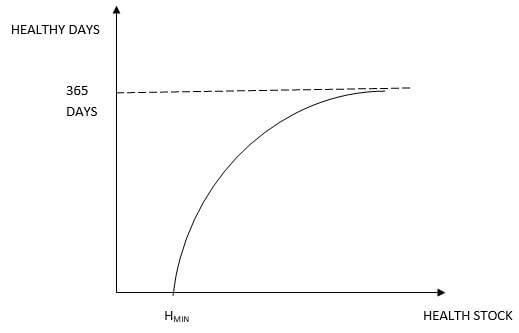
From the figure above, it can be seen that health is a productive good which produces healthy days. Greater health stock leads to more healthy days but with diminishing returns. Hmin is health stock minimum i.e. production of healthy days at this point is zero and the natural maximum of 365 days.
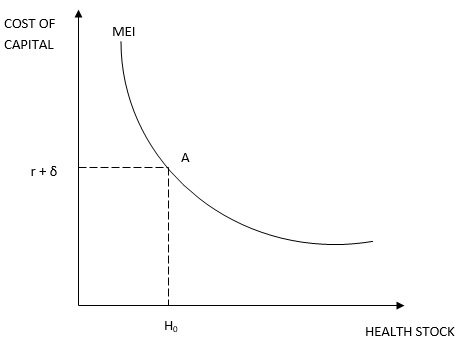
If cost of capital is r + δ, then the optimal quantity of capital is H0, A represents the point of equilibrium. Here, we can see that there is decreasing marginal efficiency of health investment with the size of the health capital. The rate of depreciation increases i.e. due to aging, then the optimal size of the health capital is reduced. Health capital will decrease over the years and eventually hit the level of 0, presumably to be interpreted as retirement.
Changes in Demand for Health Equilibrium
1. Effect of age on demand for human health capital:
The rate at which health stock depreciate may increase during some periods of life and decline during others because as an individual grows old the δ rate of health stock is likely to increase (from δ to δ1 and then to δD) i.e. the health of older individuals is likely to deteriorate faster than the health of younger individuals. Here it is believed that as the optimal health stock decreases with age, it does not affect wage and other factors which help in determining the MEI. The MEI curve slopes downwards because the production function for healthy days will have diminishing marginal returns.
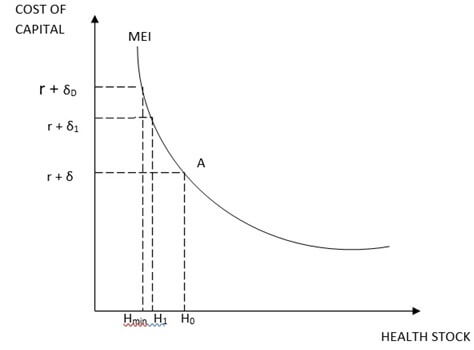
2. Effect of wage on demand for health capital:
Wage change does not affect the cost of capital because (r + δD) is constant. Increased wage rate increases return that are obtained from health days, hence a higher MEI curve i.e. if the original MEI curve represents lower-wage case, then optimal health stock is HO. MEI 2 shows MEI for someone with higher wages, with higher optimal health stock (H2). Thus, optimal health stock increases with level of wages (i.e. H2 > H0). Benefits of being healthy are greater for higher-wage workers.
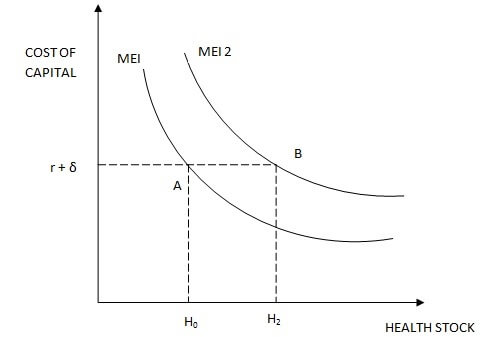
An increase in wage raises the returns on healthy days. The optimal level of H is thus higher. But investment in human capital also needs an input of time which increases the costs of such investment.
3. Effect of Education on Grossman Model’s demand for health capital:
Education improves efficiency in production. Higher education level raises marginal product of direct inputs i.e. less inputs are needed to produce a given amount of investment. A given investment can be generated at less cost for an educated person, hence will generate higher rate of return to a given stock of health. Higher education level means a higher MEI curve (similar to effect of increased wage rate). Thus, optimal health stock increases with level of education (i.e. H2 > H0). Therefore, a more knowledgeable person will choose a higher optimal stock of health than the less well-informed person.
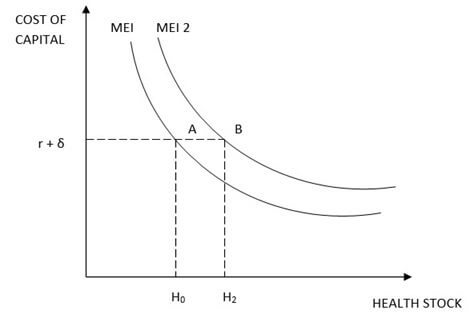
Education increases the efficiency of non-market production i.e. it increases the marginal productivity of health inputs thereby raising the optimal health stock. Also, better educated may enjoy exercise, healthy food etc. and may be able to follow treatments.
Implications for demand for health: Raise education amongst the poorly educated, reduce price of health care, especially to the poor, increase wages of the low paid and use policies to affect depreciation. With all of this, the level of health stock can improve.
Integrated Grossman’s 4 Quadrant Model
The economics approach emphasizes the role of economic factors in shaping health-related behavior. It is referred to as the {"demand for health"} approach, since it views the individual as {"demanding"} a commodity {"health"}.
In maximising utility, subject to time and money in a given period, a consumer must allocate time between work and leisure, spend remaining leisure time on health and non-health activities, spend income earned on health (medical) and non-health (e.g. baking) resources and produce health capital that may help in future years.
1. INDIFFERENCE MAP:
W =W(H,C) where W is the well-being, H is the unit of health and C is other things in life except health.
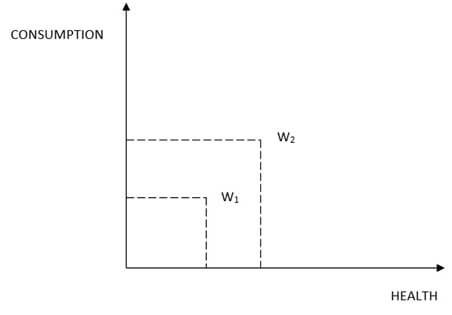
In general, the further the individual is away from the origin, the higher will be her/his well-being. Here, W2 > W1
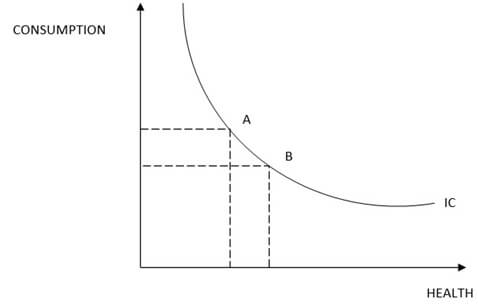
There is substitutability between health and consumption bundle. Because all the combinations of health and consumption along the contour yield the same level of welfare, the individual is {"indifferent"} between them all. Hence it is called as {"indifference curve"}. The indifference curve slopes downwards because people value both health and consumption. The welfare contour slopes downwards, therefore, because to compensate for a reduction in health, consumption has to increase and vice versa. On the indifference curve, welfare at point A= welfare at point B but with different combinations of health and consumption.
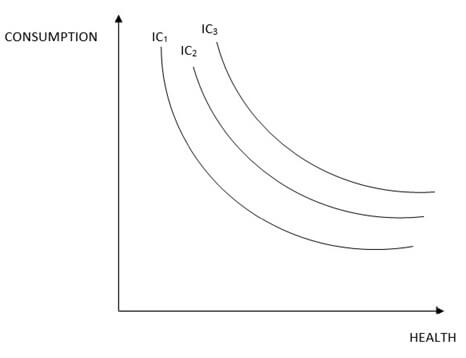
From the above figure, WIC1 < WIC2 < WIC3. The individual will therefore seek to attain the highest possible indifference curve.
2. HEALTH PRODUCTION FUNCTION:
The health production function shows how much health can be obtained from a given quantity of health input for a given state of technical knowledge. Technical knowledge is not constant over time; it changes in response to breakthroughs in medical science. As medical science progresses our understanding of the health production process increases.
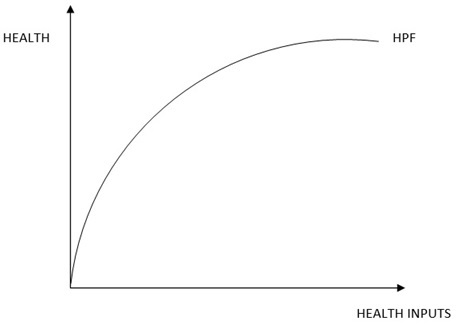
When the state of technical knowledge change, the position of the health production function also changes. As knowledge increases, so the production function shifts upwards. The effects of knowledge increasing over time also have some implications like individuals being more knowledgeable about the technology of health production than others. One might reasonably suppose that the better educated are in a better position to assimilate information about health matters from the mass-media and their physician than the poorly educated, thereby being better equipped to produce a healthy diet from a given outlay on food, to acquaint themselves with the most efficient ways to heat their homes, and to digest information about possible health hazards in their workplace. Thus, the position of an individual's health production function will depend on his education.
3. BUDGET CONSTRAINT:
Neither health inputs nor consumption activities are costless; and we have limited resources to finance health production and consumption activities. The {"budget constraint"} indicates all combinations of health inputs and consumption which exactly exhaust the individual's income.
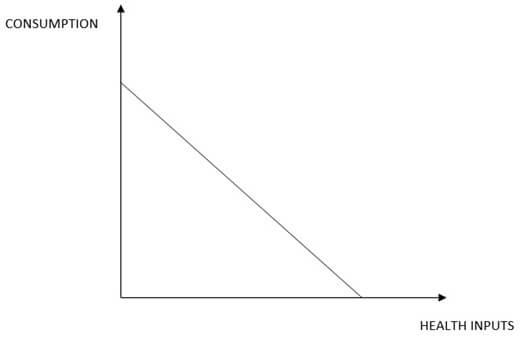
The slope of the budget constraint is the number of units of consumption which must be given up to obtain one more unit of health input or the ratio of the price of a unit of health input to the price of a unit of consumption.
4. CONSUMER EQUILIBRIUM:
The consumer will try to do the best in the given situation, in the sense that he will organize his expenditures on health inputs and consumption so as to give himself the highest possible level of well-being. Diagrammatically, s/he will seek to attain the highest IC available to her/ him subject to constraint by her/ his limited income, the prices s/he has to pay for health inputs and consumption activities, and the opportunities open to her/him for transforming health inputs into health.
Welfare Possibility Frontier (WPF) indicates all combinations of health and consumption which satisfy both the budget constraint and the health production function.
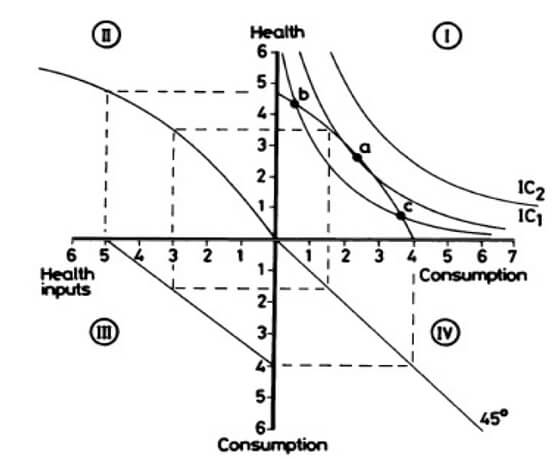
This is the integrated Grossman’s four quadrant model. All the economic approaches are combined here. The equilibrium is attained at point-a where the IC is tangent to the welfare possibility frontier.
CHANGE IN INCOME:
Suppose there is a fall in income, this will lead to a reduction in the quantity of health inputs employed and deterioration in the individual's health status. With fall in income, the budget constraint shifts inwards and thus welfare decreases.
CHANGE IN PRICES:
A fall in the price of a unit of health inputs results in the budget line moving outwards from the intercept on the consumption axis. Here, it is held that the individual did not devote all of her income to consumption before the price change; therefore, she will employ more health inputs and consequently achieve better health. This implies that subsidizing the price of health inputs results in improved health for those receiving such subsidies.
CHANGE IN TECHNICAL KNOWLEDGE:
Advances in medical science or education will cause an upward shift in the health production function. This means that the individual can reach a higher level of health for the same level of health inputs. Thus, a health education programme may bring about improved health without any increase in the demand placed on health services and other health inputs.
Criticism of Grossman’s Model
- This model assumes health care is a constant life time investment but this does not happen generally.
- It ignores the importance of insurance markets specially health insurance.
- It assumes perfect information on the part of consumers about the MEC of health care, interest rates, depreciation, etc. for now and the future.
- It is also deterministic because it includes the choice of when to die which is impractical. Also, it does not take into account the often-observed random occurrences of illnesses.
Conclusion Summary of Grossman’s Model
The Grossman model is important not only in emphasizing the distinction between demand for health and demand for healthcare, but also in demonstrating that health is both an investment and a consumption commodity. The model can be used to predict the likely (and opposite than intended) effects of policy changes like the government may attempt to reduce queuing time in order to encourage greater utilization of health care by the poor. This generally increases the MEC of both rich and poor but since the value of extra time is greater for the rich, the MEC shifts up further for the rich and results in increasing the inequality.
Also, this model discussed how optimal health stock decreases as the person ages because the depreciation rate of health increases as a person ages, advantages of good health are greater for high wage workers so they demand higher optimal health stock, more educated people generate better health status because they are well-informed and individuals allocates resources in order to produce health capital.
Grossman model has been significant in health economics. Demand for health care inputs are thus, demand derived from demand for health itself. This model has yielded substantial insight into the determinants of health and into the allocation of time and money into health production.
AssignmentHelp’s online tutors for Health Economics Assignments
Looking for expert economics online tutors for understanding concepts like human capital, care market, marginal efficiency of capital, medical economics, and health production function? Look no further than www.assignmenthelp.net At Assignmenthelp, we have the best online health economics tutors who will help you get the best grade on your healthcare economics essays, medical economics term papers and thoroughly explain you the concept of supply and demand in healthcare economics. Writing an economics term paper related to health economic modelling, then you definitely need the support of Assignmenthelp’s best online economics faculty that will work with you to explain you the difficult concepts underlying derived demand, Grossman’s model for healthcare demand and are readily available to help you with literature review for health economics research essay problems as well.
For help with economic analysis in healthcare assignments immediately contact Assignmenthelp’s online economics tutors and ace your course.
